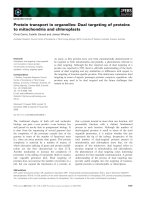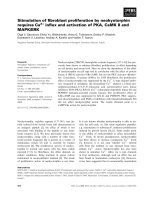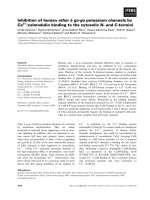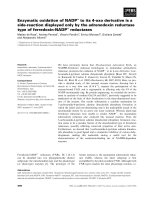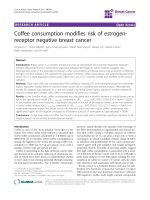Dual activation of estrogen receptor a and aryl hydrocarbon receptor by the prenylflavone, icaritin restrict breast cancer cell growth and destabilize estrogen receptor a protein
Bạn đang xem bản rút gọn của tài liệu. Xem và tải ngay bản đầy đủ của tài liệu tại đây (1.04 MB, 134 trang )
DUAL ACTIVATION OF ESTROGEN RECEPTOR α
AND
ARYL HYDROCARBON RECEPTOR
BY THE PRENYLFLAVONE, ICARITIN
RESTRICT BREAST CANCER GELL GROWTH
AND
DESTABILIZE ESTROGEN RECEPTOR α PROTEIN
TIONG CHI TZE
B.Sc. (Hons), NTU
A THESIS SUBMITTED
FOR THE DEGREE OF MASTER OF SCIENCE
DEPARTMENT OF OBSTETRICS AND GYNAECOLOGY
NATIONAL UNIVERSITY OF SINGAPORE
2010
ii
ACKNOWLEDGEMENTS
I would like to express my heartfelt gratitude to my supervisor Prof.
Yong Eu Leong and my co-supervisor Dr. Li Jun for their invaluable
supervision, support and guidance throughout the course of this endeavor.
I am grateful to the ex-postdoctoral fellow in the laboratory, Dr. Shen
Ping for her encouragement, technical help and critical comments. My
gratitude goes to Wilson Wong, for helping me in the microarray data analysis.
I am greatly appreciative of all the laboratory members (Vanessa, Faisal,
Eileen, Dr. Shijun, Gaik Hong and Seok Eng) who have generously extended
their warm friendship and assistance. Their presence made the laboratory an
enjoyable place to work in. Many special thanks to my family members and
friends for their constant support and encouragement.
Above all, to God be the glory for His guidance and providence.
iii
TABLE OF CONTENTS
ACKNOWLEDGEMENTS ............................................................................................. ii
TABLE OF CONTENTS ................................................................................................ iii
SUMMARY ...................................................................................................................... vi
LIST OF TABLES ......................................................................................................... viii
LIST OF FIGURES ......................................................................................................... ix
ABBREVIATIONS ........................................................................................................... x
CHAPTER 1
1.1
INTRODUCTION................................................................................. 1
Breast cancer ..................................................................................................... 1
1.1.1 Risk factors for breast cancer ............................................................................. 2
1.2
Estrogens............................................................................................................ 4
1.2.1 Physiological roles of estrogens ......................................................................... 4
1.2.2 Metabolism of estrogens .................................................................................... 8
1.2.3 Estrogens and mammary gland .......................................................................... 8
1.3
Estrogen receptors ............................................................................................ 9
1.3.1 Structure of ERα and ERβ ................................................................................. 9
1.3.2 ER signaling ..................................................................................................... 11
1.3.3 Co-activators and co-repressors of ER ............................................................. 11
1.3.4 Proteasome-dependent degradation of ERα protein ......................................... 12
1.4
Selective estrogen receptor modulators (SERMs) and treatment of
breast cancer................................................................................................................ 14
1.4.1 Breast cancer treatments .................................................................................. 14
1.4.2 Selective estrogen receptor modulators (SERMs) ........................................... 16
1.5
Aryl hydrocarbon receptor ............................................................................ 18
1.5.1 Structure and function of AhR ......................................................................... 18
1.5.2 AhR signal transduction pathway .................................................................... 18
1.5.3 Cross-talk of AhR with ERs ............................................................................ 21
1.5.4 Ubiquitin ligase activity of AhR and degradation of ERα ............................... 22
1.6 Phytoestrogens and breast cancer ....................................................................... 24
1.6.1 Classification of phytoestrogens ...................................................................... 24
1.6.2 Functional similarity of phytoestrogens and estrogens .................................... 24
1.6.3 Phytoestrogens and risk of breast cancer ......................................................... 25
iv
1.6.4 Potential mechanism for stimulatory effect of phytoestrogens on breast
cancer ........................................................................................................................ 26
1.6.5 Potential mechanism for inhibitory effect of phytoestrogen on breast cancer . 27
1.7
Herba Epimedii flavonoids and cancer cell proliferation ........................... 30
1.7.1 Traditional use of Herba Epimedii ................................................................... 30
1.7.2 Modern use of Herba Epimedii ........................................................................ 30
1.7.3 Chemical constituents of Herba Epimedii ....................................................... 31
1.7.4 Geographical distribution of Herba Epimedii in China ................................... 32
1.7.5 Epimedium flavonoid and cancer cell proliferation ......................................... 32
1.8
Icaritin and cancer cell proliferation ............................................................ 36
1.8.1 Icaritin and cancer cell proliferation ................................................................ 36
1.8.2 Bioavailability of icaritin ................................................................................. 39
1.9
Combinatorial effects of estradiol and phytoestrogen on cancer cell risk . 42
1.10
Objectives......................................................................................................... 47
CHAPTER 2
2.1
MATERIALS and METHODS.......................................................... 48
Materials .......................................................................................................... 48
2.1.1 Cell culture media, supplements, trypsin and antibiotics ................................. 48
2.1.2 Compounds and antibodies .............................................................................. 49
2.1.3 Assay systems .................................................................................................. 50
2.1.4 Equipments ...................................................................................................... 50
2.1.5 Probes for real-time PCR ................................................................................. 51
2.1.6 siRNAs ............................................................................................................. 51
2.2
Mammalian cell culture .................................................................................. 52
2.2.1 Dextran-coated charcoal treated FBS preparation ........................................... 52
2.2.2 MCF-7 cell line ................................................................................................ 53
2.2.3 MDA-MB-231 cell line .................................................................................... 53
2.2.4 ERα stable cell line .......................................................................................... 53
2.3
Human breast cancer cell proliferation assay .............................................. 54
2.4
Plasmid DNA purification and nucleofection ............................................... 55
2.4.1 Plasmid DNA purification ............................................................................... 55
2.4.2 Plasmid DNA nucleofection ............................................................................ 56
2.5
Reporter gene assay ........................................................................................ 57
2.5.1 ER responsive reporter assay ........................................................................... 57
2.5.2 AhR responsive reporter assay ......................................................................... 57
2.6
Real-time PCR experiment ............................................................................ 58
v
2.6.1 Total RNA extraction ....................................................................................... 58
2.6.2 cDNA synthesis ............................................................................................... 58
2.6.3 Real-time PCR ................................................................................................. 59
2.7
Western blotting .............................................................................................. 60
2.7.1 Cellular protein extraction ............................................................................... 60
2.7.2 SDS-polyacrylamide gel electrophoresis ......................................................... 60
2.7.3 Western blot detection and analysis ................................................................. 61
2.8
Competitive ligand binding assay .................................................................. 62
2.8.1 ERα competitive ligand binding assay ............................................................. 62
2.8.2 AhR competitive ligand binding assay ............................................................ 62
2.9
AhR knockdown .............................................................................................. 64
2.10
Global gene expression profiling ................................................................... 65
2.11
Statistical analysis ........................................................................................... 67
CHAPTER 3
3.1
RESULTS ............................................................................................ 68
Icaritin as a phytoestrogen ............................................................................. 68
3.1.1 Icaritin induced a dose-dependent stimulatory/inhibitory effect on MCF-7
proliferation .............................................................................................................. 69
3.1.2 Icaritin bound directly to ERα .......................................................................... 72
3.2
Combinatorial effect of estradiol and icaritin .............................................. 74
3.2.1 Estradiol/icaritin in combination exerted lower proliferative effect than
estradiol alone ........................................................................................................... 74
3.2.2 Estradiol/icaritin in combination induced lower GREB1 gene expression
compared to either ligand alone ................................................................................ 76
3.2.3 Estradiol/icaritin in combination induced lower ER-regulated promoter
activity compared to either ligand alone ................................................................... 78
3.3
Icaritin as an AhR agonist .............................................................................. 81
3.3.1 Icaritin induced CYP1A1 gene expression ...................................................... 81
3.3.2 Icaritin induced AhR-regulated promoter activity ........................................... 87
3.3.3 Icaritin bound directly to AhR ......................................................................... 89
3.4
Estradiol/icaritin in combination destabilized ERα protein more than
either ligand alone ....................................................................................................... 91
3.5
AhR knockdown reversed icaritin modulation of estradiol stimulated
MCF-7 cell proliferation............................................................................................. 95
CHAPTER 4
DISCUSSION ...................................................................................... 97
BIBLIOGRAPHY ......................................................................................................... 107
vi
SUMMARY
Hormone replacement therapy (HRT) is usually prescribed to
postmenopausal women suffering from menopausal symptoms such as hot
flushes, vaginal atrophy, reduced sexual function and depression. However,
according to Women Health Initiative from United States National Institute of
Health (US NIH), the use of HRT is associated with 26% increase in breast
cancer risk. On the other hand, epidemiological evidence suggests that
phytoestrogen might be beneficial for alleviating menopausal symptoms
without increasing the risk of breast cancer. As such, we have chosen to study
icaritin, a phytoestrogen derived from Herba Epimedii. Herba Epimedii is a
medicinal herbal plant traditionally prescribed for improving bone health,
amongst other indications. Since 17β‐estradiol (estradiol) is naturally present
in the body even after menopause, the combinatorial effect estradiol and
icaritin has relevance to the use of these compounds in subjects at risk of or
suffering from breast cancer. Hence, as the initial step, we performed in vitro
study to test the combinatorial effects icaritin and estradiol on MCF-7 breast
cancer cell.
Icaritin increased MCF-7 breast cancer cell proliferation at doses less
than 10 µM. However, the combination of 1 µM of icaritin with 100 pM
estradiol inhibited the cell growth induced by estradiol. Estradiol/icaritin
combination also induced lower estrogen receptor (ER)-regulated promoter
activity and decreased GREB1 (growth regulation by estrogen in breast cancer
1) mRNA level compared to either ligand alone.
vii
As we were interested to investigate the molecular basis for this effect,
we used a bioinformatics approach to fish for genes that are differentially
regulated by icaritin. Microarray analyses directed our attention to CYP1A1
gene, an AhR-regulated gene. Independent quantitative real-time PCR
experiments confirmed that icaritin induced CYP1A1 and the AhR-regulated
XRE promoter, linking icaritin to the AhR-regulated signaling pathways.
Knockdown of AhR blocked the profound degradation of ERα induced by
estradiol/icaritin combination, indicating the central role of icaritin on AhRmediated receptor stability. In contrast, knockdown of AhR gene did not
restore estradiol-mediated degradation of ERα, consistent with the fact that
estradiol is not a ligand for AhR. AhR knockdown blocked suppressive effects
of icaritin on estradiol-stimulated breast cancer cell proliferation and GREB1
gene expression. Our study indicates that icaritin can modulate estradiolstimulated
MCF-7
cell
proliferation
via
AhR-mediated
proteasomal
degradation of ERα to decrease GREB1 mRNA level.
In conclusion, the concurrent use of icaritin with estradiol reduces
estradiol-stimulated MCF-7 cell growth in vitro via activation of AhR-E3
ubiquitin ligase pathway. Based on the in vitro study, icaritin might be further
developed as a drug to be co-administered with HRT to reduce breast cancer
risk caused by HRT.
viii
LIST OF TABLES
Table 1.1 Reference intervals for estrone and estradiol in adult males, pre- and
postmenopausal females .................................................................................... 6
Table 1.2 Serum estrone and estradiol levels in postmenopausal women
receiving HRT every other day and every day. ................................................. 6
Table 1.3 Randomized controlled trials to test the effect of estrogen plus
progestin therapy in postmenopausal hormone therapy and recurrence of
breast cancer....................................................................................................... 7
Table 1.4 Classes of phytoestrogens. .............................................................. 24
Table 1.5 Major and minor flavonoid in Herba Epimedii species .................. 32
Table 1.6 Summary of Herba Epimedii extracts and flavonoid and its effects
on cancer growth. ............................................................................................. 34
Table 1.7 Summary of effect of icaritin on cancer growth. ............................ 38
Table 1.8 Concentration-time profiles of Herba Epimedii prenylflavonoids.. 41
Table 1.9 Summary of effects of phytoestrogen and estradiol combination on
cancer growth. .................................................................................................. 45
Table 3.1 List of genes that are differentially regulated by icaritin treatment
compared to estradiol and 4-hydroxytamoxifen. ............................................. 84
ix
LIST OF FIGURES
Figure 1.1 Schematic drawing of steroid hormone receptors ......................... 10
Figure 1.2 Ligand activated signal transduction of AhR. ............................... 20
Figure 1.3 Different modes of the AhR signaling pathways........................... 23
Figure 1.4 Structures of icariin and its derivatives. ........................................ 40
Figure 3.1 Effect of icaritin on MCF-7 or MDA cell proliferation................. 71
Figure 3.2 Competitive binding of icaritin to ERα. ........................................ 73
Figure 3.3 Effect of estradiol and icaritin combination on MCF-7 cell
proliferation...................................................................................................... 75
Figure 3.4 Effect of estradiol and icaritin on GREB1 mRNA expression ...... 77
Figure 3.5 Effect of icaritin on ERα reporter gene assay ................................ 80
Figure 3.6 Hierarchical clustering of differentially expressed gene after
icaritin treatment. ............................................................................................. 83
Figure 3.7 Effect of icaritin on CYP1A1 gene expression ............................. 86
Figure 3.8 Effect of icaritin on XRE reporter gene assay. .............................. 88
Figure 3.9 Competitive binding of icaritin to AhR. ........................................ 90
Figure 3.10 Western blotting for ERα protein stability. ................................. 94
Figure 3.11 Effect of AhR knockdown on MCF-7 cell proliferation and
GREB1 expression ........................................................................................... 96
Figure 4.1 Crosstalk between icaritin and estradiol signaling pathways
through AhR-directed proteasomal degradation. ........................................... 106
x
ABBREVIATIONS
AhR
AhRR
ARNT
AR
CI
CO2
CT-FBS
CYP1A1
DBD
DMSO
DNA
dNTP
E1
Estradiol
E3
EB
ER
ERα
ERβ
EMEM
ERE
FBS
g
GEN
GR
GREB1
HRE
HRT
HSP
ICT
kb
kDA
l
LB
LUC
M
µg
µl
mg
mM
mRNA
N-CoR
NLS
NR
nM
ng
aryl hydrocarbon receptor
aryl hydrocarbon receptor repressor
AhR nuclear translocator
androgen receptor
confidence interval
carbon dioxide
charcoal treated-fetal bovine serum
Cytochrome P450, family 1, subfamily A, polypeptide 1
DNA binding domain
dimethyl sulfoxide
deoxyribonucleic acid
deoxynucleotide triphosphates
estrone
17β-estradiol
estriol
Epimedium brevicornum
estrogen receptor
estrogen receptor alpha
estrogen receptor beta
Eagle’s minimum essential medium
estrogen response element
fetal bovine serum
gram
genistein
glucocorticoid receptor
growth regulation by estrogen in breast cancer 1
hormone response elements
hormone replacement therapy
heat shock protein
icaritin
kilobases
kilodalton
litre
Luria-Bertani
luciferase
molar
microgram
microlitre
milligram
millimolar
messenger ribonucleic acid
nuclear receptor co-repressor
nuclear localisation signal
nuclear receptor
nanomolar
nanogram
xi
OD
PBS
PCR
PPAR
pM
PR
RLU
RNA
rpm
RPMI 1640
RR
SDS-PAGE
electrophoresis
SEM
SERM
SRC
TCDD
TCM
XRE
3MC
4-OHT
optical density
phosphate buffered saline
polymerase chain reaction
peroxisome proliferator-activated receptor
picomolar
progesterone receptor
relative luciferase unit
ribonucleic acid
revolutions per minute
Roswell Park Memorial Institute Media 1640
relative risk
sodium dodecyl sulfate-polyacrylamide gel
standard error of mean
selective estrogen receptor modulator
steroid receptor co-activator
2,3,7,8- tetrachlordibenzo-p-dioxin
Traditional Chinese Medicine
xenobiotic response element
3-methylcholanthrene
4-hydroxytamoxifen
1
CHAPTER 1
1.1
INTRODUCTION
Breast cancer
Breast cancer is currently the most prevalent malignancy among
women in developed societies. According to World Health Organisation’s Fact
sheet N°297 published in February 2009, breast cancer is one of the top five
leading causes of deaths worldwide (519 000 deaths, 2004). It is ranked as the
most frequent type of cancer causing death in women worldwide. In the local
context, according to Singapore Cancer Registry, Interim Report entitled
Trends in Cancer Incidence in Singapore 2003-2007, breast cancer is the
number one cancer affecting local Singapore women with 6798 sufferers. It is
a health burden worldwide, affecting women from high to low-resource
settings. Despite the availability of therapies targeting estrogen and growth
factor signaling pathways, the incidence and mortality of breast cancers have
not decline at the same rate as other major causes of death, highlighting the
need for new therapeutics strategies. Notably, majority of breast cancers
express the estrogen receptor (ERα), a member of the nuclear receptor (NR)
superfamily of ligand-inducible transcription factors, and thus respond to
mitogenic actions of estrogen(s).
Studies on cancer cases in the five continents of the world have shown
that there are at least 10-fold variation in the occurrence of breast cancer
worldwide (Parkin et al, 1992), most probably due to differences in socioeconomic status giving rise to reproductive, hormonal and nutritional factors.
The highest incidence rates occur in northern Europe, northern America,
2
Australia and New Zealand, and in the southern countries of South America,
especially Uruguay and Argentina (Bray et al, 2004). Incidences is low
throughout Asia, Africa and most of the Central and South America (Bray et
al, 2004).
Breast cancer incidence shows a distinctive age-specific curve, with
rapid increase before menopause (40 - 50 years old). The rate slows down
thereafter, most likely due to the decrease in estrogen level due to start of
menopause (Bray et al, 2004). The duration of exposure to endogenous
ovarian hormones might be related to breast cancer risk, with a year delay in
the onset of menarche associated with 5% reduction of breast cancer risk
(Hunter et al, 1997).
1.1.1 Risk factors for breast cancer
In general, the population lifetime risk of being diagnosed with breast
cancer is one in eight to one in twelve (Amir et al, 2010). Risk factors such as
use of hormone replacement therapy (HRT), reproductive history and
hormonal contraceptive use can substantially modify the risk of developing
breast cancer.
Hormone replacement therapy (HRT) is one of the most commonly
prescribed drug regimens given to postmenopausal women to alleviate the
menopausal symptoms such as hot flushes, depression, mood swings and
sleeping disorders. However, recently, the dissemination of results from the
Women’s Health Initiative (WHI) clinical trial in 2002 brought to light the
risks associated with use of HRT and increased risk of breast cancer.
3
According to the study, the use of HRT is associated with 26% increase in
breast cancer risk. Another study, observational Million Women Study (MWS)
found that the risk of breast cancer increases with duration of HRT use. Ten
years' use of HRT is estimated to result in five additional breast cancers per
1000 users of estrogen-only preparations and 19 additional cancers per 1000
users of oestrogen-progestagen combinations.
Women who had first pregnancy at an early age are observed to have
lower incidence of breast cancer. This is probably due to the longer breastfeeding duration exerting protective effect against breast cancer (Beral, 2003).
A study done by Collaborative Group on Hormonal Factors in Breast Cancer
found that the risk of breast cancer decreased with the number of child births.
Each child birth decreased the risk of breast cancer by approximately 7%.
However, this birth related decrease in breast cancer risk is dependent on the
age of first child birth. Women who have their first child before 20 years old
shows a 30% decrease in risk than women with who give birth to their first
child after the age of 35 (Kabuto et al, 2000).
In 1996, the Collaborative Group on Hormonal Factors in Breast
Cancer conducted a study to investigate the association between hormonal
contraceptives use and breast cancer. From the study, it was concluded that
contraceptive usage is associated with slightly higher risk of breast cancer.
Nevertheless, there is no evidence of significant excess risk of breast cancer
diagnosed due to prolong use (> 10 years) of oral contraceptive pills. The issue
is debatable, partly due to the changing formulations in the contraceptives
(Hankinson et al, 1997; Kumle et al, 2002; Magnusson et al, 1999;
Marchbanks et al, 2002).
4
1.2
Estrogens
1.2.1 Physiological roles of estrogens
Estrogens are pivotal hormones in the progression of the majority of
human breast cancers. Estrogens influence growth, differentiation and function
of tissues of the female reproductive system, i.e., uterus, ovary, and breast as
well as non-reproductive tissues such as bone and cardiovascular system. The
effects of estrogens in tissues are mediated by ERα and ERβ, expressed to
varying extent in most organs, including uterus, ovary, breast, brain, lung,
liver, prostrate, testis and kidney. Most early stage mammary tumors are ER
positive and are responsive to endocrine therapies which target ERα and/or
estradiol biosynthesis.
There are three forms of estrogen, namely 17β-estradiol (estradiol),
estrone (E1) and estriol (E3). However, the most prevalent form of human
estrogen is estradiol. Estrogens are produced and secreted by the theca and
granulose cells of the ovaries. The biological actions of estrogens are regulated
by their concentration in the circulation, the intracellular conversion into more
or less active derivatives and the ER concentration in the target tissues. The
source of circulating estrogens in premenopausal women is predominantly the
ovary and uptake of hormone from circulation is the primary mechanism for
maintenance of estradiol concentration in breast cancer tissues. This situation
changes drastically in postmenopausal women. Menopause is a naturally
occurring physiological condition in every woman with an average age of
onset at 51 years old. It is a permanent cessation of menstruation due to loss of
ovarian follicular function. The symptoms include hot flushes, vaginal atrophy,
reduced sexual function and depression. The syndromes include coronary
5
heart disease and osteoporosis. To alleviate these symptoms, the women are
given hormone replacement therapy (HRT) which is combination of
conjugated equine estrogen and medroxyprogesterone acetate. HRT is able to
increase estradiol levels in postmenopausal women from < 36 pM to 100 pM
(Table 1.1 and Table 1.2) (Nelson et al, 2004; Yasui et al, 2005). However,
studies from US NIH (Women Health Initiative) indicated that HRT in
menopausal women is associated with 26% increase in breast cancer risk. On
top of that, data suggest that use of HRT in breast cancer survivors may
increase the chance of breast cancer recurrence (Table 1.3) (Holmberg et al,
2004; Holmberg et al, 2008; Marsden et al, 2000; von Schoultz et al, 2005).
6
Table 1.1 Reference intervals for estrone and estradiol in adult males, pre- and
postmenopausal females. [Figure adapted from (Nelson et al, 2004)].
N
Adult males
32
Premenopausal females 92
Postmenopausal females 30
Estrone, (pM)
37 to 200
62 to 740
25 to 148
Estradiol (pM)
36 to 147
55 to 1280
<36
Table 1.2 Serum estrone and estradiol levels in postmenopausal women
receiving HRT every other day and every day. Serum estrogen levels are
measured in 84 postmenopausal women (HRT every day: 38 women; HRT
every other day: 46 women). Fasting blood samples were drawn 12–18 hours
after HRT. [Figure adapted from (Yasui et al, 2005)].
Means + S.D
Estrone (pM)
Before HRT every day
75.1+ 38.8
Before HRT every other day 57.7 + 30.0
After HRT every day
665.5 + 276.6
After HRT every other day
270.0 + 138
Estradiol (pM)
19.5+ 15.1
17.6 + 13.6
115.4 + 29.4
52.5 + 12.8
7
Table 1.3 Randomized controlled trials to test the effect of estrogen plus
progestin therapy in postmenopausal hormone therapy and recurrence of
breast cancer. Table shows the risk of breast cancer recurrence in breast cancer
survivors after hormone replacement therapy. [Figure adapted from
(Holmberg et al, 2004; Holmberg et al, 2008; Marsden et al, 2000; von
Schoultz et al, 2005)].
Author
Marsden
et al.
Holmberg
and
Anderson
von
Schoultz
and
Rutqvist
Patients
in
hormone
Journal therapy
Fertil.
Steril
50
Lancet
174
Number of
Patients
recurrences
in
placebo Duration (hormone
group
of study therapy/control
6
50
months
2/1
171
J Natl
Cancer
Inst
188
190
J Natl
Holmber Cancer
Inst
221
221
et al.
CI, confidence interval; RR, relative risk
RR
(95%
CI)
26 / 7
2
3.3
(1.51.7)
4.1
years
11/ 13
0.82
(0.350.19)
4 years
39 / 17
2.29
2.1
years
8
1.2.2 Metabolism of estrogens
Estrogens are metabolized by sulfation or glucuronidation and the
conjugates are excreted into the bile or urine. Hydrolysis of these conjugates
by the intestinal flora and subsequent re-absorption of the estrogen result in an
enterohepatic circulation of estrogen. Estrogens are also metabolized by
hydroxylation and subsequent methylation to form catechol and methoxylated
estrogens (Osawa et al, 1993). Hydroxylation of estrogens yields 2hydroxyestrogens, 4-hydroxyestrogens and 16α-hydroxyestrogens (catechol
estrogens). 4-hydroxyestrone and 16α-hydroxyestradiol are carcinogenic.
1.2.3 Estrogens and mammary gland
Estrogens are necessary for normal development, induction and
progression of mammary carcinoma. Mitogenic actions of estrogens are
critical in the etiology and progression of human breast and gynaecologic
cancers. Some breast cancers are responsive to estrogens for growth.
Estrogens directly increased the growth of breast cancer cells in culture by
increasing the number of G0/G1 cells entering into the cell cycle (DoisneauSixou et al, 2003). Although estrogens play important roles in the initiation
and development of breast cancer, the exact mechanism(s) by which estrogens
regulate mammary epithelial cell proliferation is not well defined.
When estrogen molecules circulate in the bloodstream and move
throughout the body, they exert effects only on cells with ERs. Tissues that
express ERs include mammary gland, uterus, vagina, ovary, testes, epididymis
and prostate (Conneely, 2001; Pettersson et al, 2001).
9
1.3
Estrogen receptors
There are two forms of ER, ie ERα and ERβ. Both ERα and ERβ are
members of the steroid receptor super family of nuclear transcription factors
(Mangelsdorf et al, 1995). ERβ is expressed mainly in human tissues such as
the central nervous system, gastrointestinal tract, kidneys and lungs (Omoto et
al, 2001). In contrast, ERα seems to predominate in reproductive tissues such
as the uterus and breast, although a small amount of ERβ is also present in
these tissues. In tissues where both ERα and ERβ are co-expressed, it has been
found that ERβ opposes ERα’s action. Hence, the estrogen action in tissues
where both receptors are co-expressed is very complex (Nilsson et al, 2001).
1.3.1 Structure of ERα and ERβ
The human ERα transcript encodes a protein of 595 amino acids with
an approximate molecular mass of 66 kDa (Green et al, 1986; Walter et al,
1985) and this gene is mapped to chromosome 6 (Menasce et al, 1993). The
human ERβ is slightly smaller than the ERα, composed of 485 amino acids
and with estimated molecular mass of 55 kDa (Kuiper et al, 1996). In common
with other members of the steroid receptor super family, ERs are organized
into six domains (A – F) that are responsible for specific functions (Greschik
et al, 2003; Katzenellenbogen et al, 1996; Robinson-Rechavi et al, 2003)
(Figure 1.1). The N-terminal transactivation domain (TAD) has a ligandindependent activation function. The DNA-binding domain (DBD) enables
receptor binding to estrogen response element (ERE). The DBDs of ERα and
ERβ share approximately 97% sequence homology but significant differences
10
in amino-acid sequences are found in the N-terminal and ligand-binding
domains. Both ERα and ERβ bind to ERE in promoter regions of target cells.
In addition, ERs regulate AP-1 enhancer elements by acting on the
transcription factors Fos and Jun. The ligand-binding domain (LBD) also
harbors a nuclear localization signal as well as sequences necessary for
dimerization and transcriptional activation.
Figure 1.1 Schematic drawing of steroid hormone receptors. Estrogen
receptor α (ERα) and estrogen receptor β (ERβ). (A and B) variable Nterminal region (C) conserved DNA binding domain, (D) variable hinge
region, (E) conserved ligand binding domain and (F) variable C-terminal
region. [Figure taken from (Beck et al, 2005)].
11
1.3.2 ER signaling
The most well-characterized estrogen receptor signaling occurs via
cellular genomic response where lipophilic ligands diffuse through the cellular
membrane, bind to ER, induce conformational change and release inhibitory
heat shock protein (hsp) (Chambraud et al, 1990; Redeuilh et al, 1987). This
unveils nuclear localization signal (NLS), allowing ligand bound receptor
dimer translocation into the nucleus resulting in transcriptional regulation of
target genes. Besides genomic pathway, estrogen signaling can also be
mediated through non-genomic pathways, specifically via phosphorylation at
S-118. This mechanism can be hormone-dependent or hormone-independent.
1.3.3 Co-activators and co-repressors of ER
Upon ligand binding, ERα undergoes a major conformational change,
recruits co-activator or co-repressor molecules to its cognate DNA response
element located in the promoter/enhancer elements of target genes, thereby
initiating transcription of genes that regulates the growth of breast cancer cells,
i.e. growth regulation by estrogen in breast cancer 1 (GREB1). With more
than 300 co-regulators identified (Lonard et al, 2007), ERα-mediated
transcription is a highly regulated process, involving a multitude of coregulatory factors, signaling pathways and is also critically dependent on the
stability of ERα receptor protein.
12
1.3.4 Proteasome-dependent degradation of ERα protein
Estrogen receptor is important in promoting growth and progression of
breast cancer cells. Hence, there is great interest in exploring ways to
functionally inactivate the estrogen receptor (ER), thereby suppressing the ERmediated gene expression and cell proliferation. These approaches include the
use of anti-estrogens which binds competitively to the ERα and block the
activation of the receptor. The second approach is to target proteasomal
degradation of ERα mediated primarily by ubiquitin-proteasome pathway
(Nawaz et al, 1999).
Ligand-bound ERα is demonstrated to be covalently conjugated with
ubiquitin in vitro (Nawaz et al, 1999) and in vivo (McDonnell et al, 2002;
Nawaz et al, 1999), thus targeting it for protein degradation. This process
involves addition of ubiquitin by a series of enzymes, i.e. E1 ubiquitinactivating enzymes (Uba), E2 ubiquitin-conjugating enzymes (Ubc) and E3
ubiquitin ligases (Reid et al, 2003). Protein targeting specificity relies on the
unique interaction between a particular combination of an E2 (of which there
are relatively few), an E3 (of which there are many) and target protein
(Robinson et al, 2004). There are two major types of E3s in eukaryotes,
defined by the presence of either a HECT or a RING domain. HECT ubiquitin
ligases interact with target protein, resulting in transfer of ubiquitin. An
example of E3 ubiquitin ligase with HECT domain is E6-associated protein
(E6-AP). Ubiquitin ligases with RING domain does not interact with target
protein but facilitates the interaction between target protein and E2 ligase
(Robinson et al, 2004). E3 ligase of this type includes inhibitor of apoptosis
proteins (IAPs) and murine double minute-2 (MDM2) (Robinson et al, 2004).
13
Estradiol binding accelerates ERα degradation, reducing the half life of
ERα from 5 days to 3-4 hours. Ubiquitin ligases identified as components of
the estradiol-ERα degradation system include subunits of the cullin RING
ubiquitin ligase superfamily such as MDM2, E6-AP (Shao et al, 2004) and
BRCA1. Pure antagonist fulvestrant, also known as ICI 182, 780 and marketed
by AstraZeneca as Faslodex, inhibits ERα activity by inducing rapid
downregulation of the receptor. In contrast, tamoxifen stabilized the receptor,
leading to hormone resistance and tamoxifen-activated mutant cancers.
14
1.4
Selective estrogen receptor modulators (SERMs) and
treatment of breast cancer
1.4.1 Breast cancer treatments
One of the most prevalent characteristics of breast cancer proliferation
is hormonal control of its growth, making estrogen or estrogen receptor
targeted pathways for breast cancer therapy. Estrogen receptor (ER) has been
detected in more than half of the human breast cancer cases, with 70% of these
ER-positive tumors responding to endocrine therapy (Allegra et al, 1980;
Osborne et al, 1980; Paridaens et al, 1980; Saceda et al, 1988).
The hormonal systemic therapy of ERα positive breast cancer is
targeted at two major pathways 1) blocking the synthesis of estradiol using
aromatase inhibitors (exemestane, anastrozole or letrozole) or 2) competitive
inhibition of the receptor activity using selective ER modulators (SERMs)
such as tamoxifen or selective ER down-regulators (Howell et al, 2001) such
as fulvestrant.
Although initially classified as competitive antagonists based on their
ability to oppose estrogen action in the breast, it has become clear that
SERMs, such as tamoxifen and raloxifene are pharmacologically more
complex in that they manifest agonist or antagonist activity in a cell-selective
manner. Both tamoxifen and raloxifene function as antagonists in the breast
and as agonists in the bone. Active metabolite of tamoxifen, 4hydroxytamoxifen, is a mixed antagonist (i.e. that displays agonist or
antagonist activity depending on the tissue) and ICI 182,780 (fulvestrant) is a
pure antagonist. The partial antagonist tamoxifen binds to ligand binding

